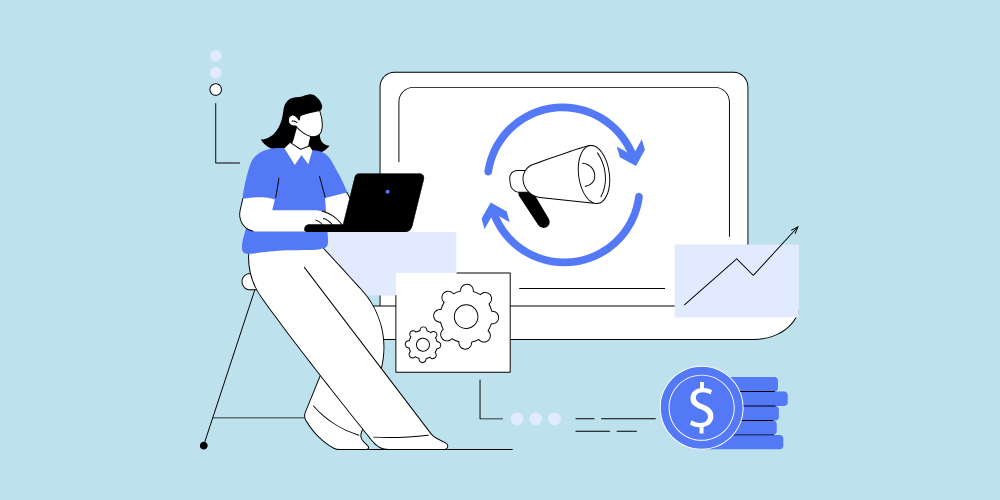Last Updated on 1 year ago by Ecem Ertürk
In the dynamic world of digital advertising, mastery of Google Ads agency techniques can redefine the success of a brand’s online presence. Among these techniques, retargeting ads on Google stand out as a game-changer, harnessing the latent potential of interested visitors by re-engaging them with targeted messages precisely when they are most likely to convert. This strategic approach not only amplifies the visibility of your brand but also significantly elevates conversion rates, carving a sustainable path to achieve superior returns on your investments in Google retargeting. Explore the pivotal strategies and concepts necessary for refining your retargeting ads to effectively capture the attention and interest of your audience.
Understanding the Basics of Google Retargeting
At the heart of enhancing online advertising strategies, Google retargeting stands as a cornerstone, allowing businesses to reconnect with potential customers who have previously shown interest in their products or services. Grasping the basics of retargeting ads on Google is essential for marketers looking to leverage Google’s powerful advertising tools to their fullest potential. This approach ensures that ads are specifically targeted to audiences who are already familiar with your brand, increasing the likelihood of conversion.
What is Retargeting and How Does it Work?
Retargeting is an online marketing technique that targets individuals who have visited a website but did not make an immediate purchase or conversion. Google retargeting ads harness this concept by displaying targeted ads to these visitors as they browse the internet. In essence, how Google retargeting works involves tagging these users through browser cookies and subsequently serving them personalized ads that remind them of the products they viewed. This strategy nudges them to revisit the website and complete a purchase, effectively optimizing the reach and impact of retargeting ads on Google.
The Role of Cookies in Retargeting
Integral to the functionality of retargeting, cookies play a pivotal role in tracking user behavior across the web. The role of cookies in retargeting cannot be overstated; they collect data on users’ site interactions, which Google then uses to inform and optimize ad campaigns. By understanding the preferences and online habits of users, businesses can retarget individuals with ads that are not only relevant but also timely, thereby significantly improving the chances of conversion.
 The Importance of Audience Segmentation in Retargeting
The Importance of Audience Segmentation in Retargeting
In the intricate landscape of digital marketing, success is often tethered to how well a brand understands and reaches out to its distinct audience segments. This is especially vital in the realm of retargeting ads on Google, where the objective is to rekindle the spark of interest among users who have previously interacted with a brand or product. It is this strategic application of audience segmentation in Google retargeting that can dramatically improve the likelihood of converting prospects into loyal customers. By leveraging Google’s robust targeting capabilities, marketers can ensure that their retargeting efforts are precisely tailored to meet the specific needs and interests of their audience segments.
Creating Buyer Personas for Tailored Advertisements
Creating buyer personas is a foundational step towards segmenting an audience with precision. These detailed profiles embody the characteristics, behavior patterns, and motivations of an ideal customer, acting as a compass for crafting ads that resonate on a personal level. Establishing these personas helps marketers to visualize the retargeting audience and to adapt messaging that aligns with the values and needs of different user groups. A brand that effectively leverages buyer personas in its retargeting efforts is more adept at producing advertisements that feel bespoke and authentic, thereby enhancing engagement rates and customer retention.
Segmenting Your Audience Based on Behavior
Another layer to the segmentation strategy lies in dividing your audience based on observable behaviors. Analyzing metrics such as website engagement, purchase history, or interactions with prior campaigns can uncover patterns that dictate future advertising approaches. Segmenting audience behavior enables a brand to deploy Google retargeting ads that are not only relevant but are also timed and positioned in response to the individual’s stage in the buying journey. The more accurately a business can identify and understand these distinct behavioral segments, the more effectively it can use retargeting ads on Google to optimize ad spend and increase conversion opportunities. This targeted approach ensures that ads are delivered to users who are most likely to convert, enhancing the overall efficiency and impact of the digital marketing strategy.
 Designing Compelling Ad Creatives for Retargeting
Designing Compelling Ad Creatives for Retargeting
Retargeting ad creatives are the linchpin in the machinery of online marketing that re-engages customers and propels conversion rates, especially when deployed as retargeting ads on Google. In crafting these creatives, every design choice must be deliberate and aimed at recapturing the wandering attention of potential customers. To achieve this, a meticulously crafted clear call-to-action (CTA) and strategic use of visual elements play pivotal roles. Attention to these elements signals the difference between a forgettable ad and one that captures interest and compels action, enhancing the effectiveness of Google retargeting campaigns.
Crafting a Clear Call-to-Action
Without a clear call-to-action (CTA), even the most creative retargeting ads on Google will falter. The CTA is the bridge between customer interest and customer action, guiding them towards the next step whether it’s to ‘Buy Now’, ‘Learn More’, or ‘Subscribe’. For retargeting ads on Google, the CTA should stand out using contrast, color, and whitespace, making it the focal point of the ad. In the arena of retargeting ad creatives, a persuasive CTA is not just an invitation; it’s an irresistible proposition that echoes the specific desires and needs of the viewer, nudging them further down the sales funnel. This strategic emphasis ensures that retargeting ads on Google effectively convert interest into action.
Using Visuals to Capture Attention in Retargeting Ads
Visual elements in retargeting ads on Google serve as the first point of engagement with your audience. They speak louder and faster than words, conveying messages through color psychology, imagery, and branding that resonate on an emotional level. Utilizing high-quality images, infographics, and even animation can make an ad more memorable and elevate the story the brand aims to tell. When these visual elements harmonize with the core message, they transform the retargeting ads on Google into a dynamic narrative that viewers are more inclined to follow, thereby increasing the likelihood of conversion.
 Optimizing Landing Pages for Retargeting Success
Optimizing Landing Pages for Retargeting Success
Landing page optimization is an indispensable component in the realm of digital marketing, particularly when it comes to retargeting landing pages. By sharpening the focus on user-centric design and content, marketing professionals can significantly propel the efficacy of retargeting campaigns. It is a decisive step towards improving landing page conversion rates, which can lead to an increase in overall return on investment for advertisers.
One of the pivotal measures in landing page optimization is the personalization of content. This involves crafting landing pages that address the distinct needs and preferences of different audience segments. Customization can range from featuring products recently viewed by the user to tailoring copy that resonates with the user’s past interactions. It’s about creating a cohesive experience that reflects the users’ journey and encourages them to take the final step in the conversion process.
Besides personalization, a fundamental aspect of optimization lies in the technical performance of the page. Ensuring fast loading times is essential, as even a second’s delay can lead to potential customers abandoning the page. With a significant portion of web traffic coming from mobile devices, improving mobile responsiveness is equally critical. A seamless mobile experience can mean the difference between losing a customer and clinching a sale.
Enriching the user experience also plays a stellar role in landing page optimization. This encompasses all facets from intuitive navigation to compelling and relevant content. Optimized landing pages help retain the user’s attention and guide them towards the intended conversion action, be it signing up for a newsletter or finalizing a purchase.
Conclusively, tapping into these techniques for landing page optimization not only serves retargeting ads on Google but also fortifies the broader marketing strategy. When the focus is on improving landing page conversion rates, it intrinsically leads to an elevated user experience, which is the hallmark of successful digital marketing campaigns. By meticulously applying these principles, businesses can craft highly effective strategies for retargeting ads on Google that translate into tangible results.
 Budgeting and Bidding Strategies for Retargeting Ads on Google
Budgeting and Bidding Strategies for Retargeting Ads on Google
Navigating the fiscal aspects of digital marketing is essential, with retargeting ads budgeting and bidding strategies at the forefront for driving ad performance efficacy. Establishing a savvy budget and adaptive bidding approach facilitates a balanced investment, ensuring each dollar propels the business closer to its desired outcomes—maximizing ROI and enhancing the overall value of retargeting campaigns.
Maximizing ROI with Strategic Bid Adjustments
To optimize the impact of retargeting ads on Google, marketers must hone their approach to bid adjustments. This entails a nuanced understanding of retargeting dynamics where bid strategies are not static but dynamic, shifting in response to a variety of factors, including audience characteristics, device usage trends, and even temporal elements such as time of day or week. Strategically managing these variables through bid adjustments can result in a more cost-effective allocation of the advertising budget, potentially increasing campaign performance and ROI.
Analyzing Retargeting Ad Performance and KPIs
Analytic rigor is key when assessing the effectiveness of retargeting efforts. Delving into ad performance analytics offers invaluable insights, guiding necessary campaign tweaks to maintain efficiency. Utilizing data-driven insights, marketers can evaluate where the campaigns stand against key performance indicators (KPIs), making them indispensable tools for continuous enhancement. By quantifying success through these metrics, brands can ascertain whether their bidding strategies align with their conversion objectives and overall retargeting goals.
 Adjusting Campaigns Based on Data-Driven Insights
Adjusting Campaigns Based on Data-Driven Insights
The iterative process of managing retargeting ads on Google allows for adjustments to be informed by hard data. By analyzing ad performance and KPIs, advertisers can identify trends and patterns that signal when to pivot strategy or double down on what works. Adjustments are not limited to bids alone; they span creative iterations, audience re-segmentation, and even landing page optimizations – all aiming for the same target: improved campaign results and ROI for retargeting ads on Google. This responsive stance to campaign management ensures that strategies remain agile and that businesses can react swiftly to the ebbs and flows of user engagement and conversion rates.












